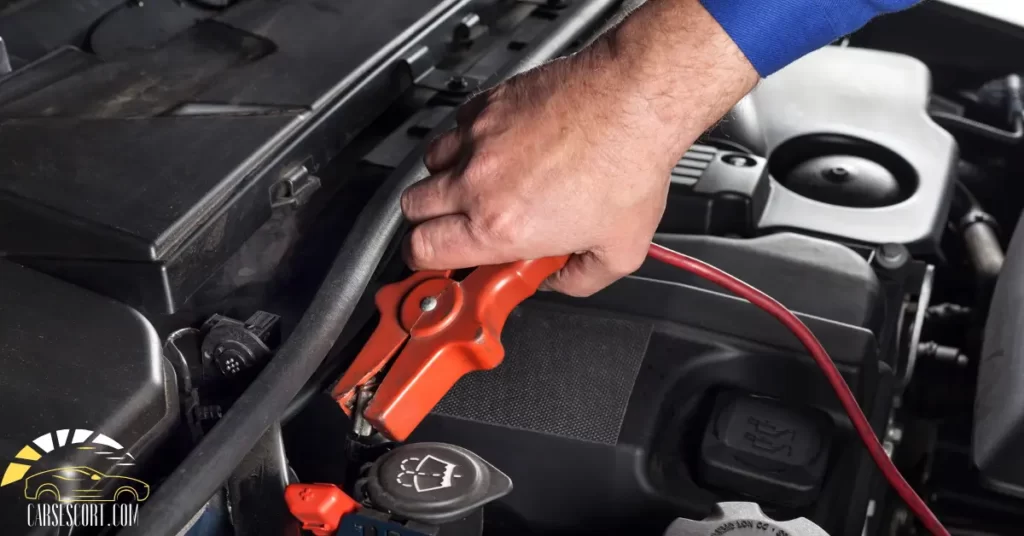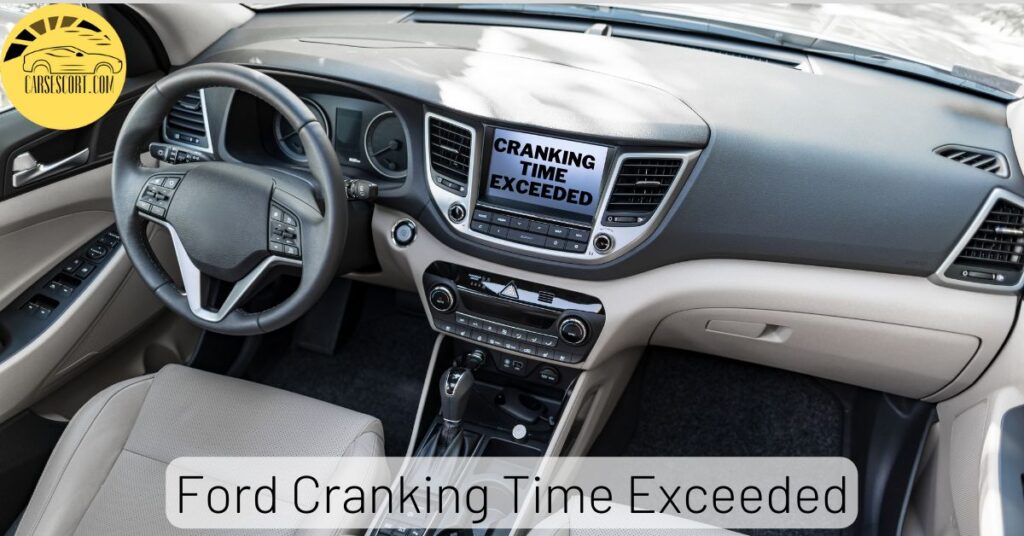If you own a Ford vehicle, you may have encountered the term “Cranking Time Exceeded” while troubleshooting starting issues. This error code typically appears on certain Ford models, including the Fiesta, Focus, Mode, Taurus, Ford F150, f250, Edge, and Fexplorer. It signifies that the vehicle has attempted to start for over 40-60 seconds without success.
Cranking time exceeded usually occurs due to a faulty fuel system, corrosion on battery terminals, insufficient power supply to the starter solenoid, ignition system issues, or mechanical problems in the engine.
The purpose of the system is to prevent damage to the engine or fuel system by limiting the duration of the cranking or starting attempt. The specific time duration may vary depending on the make and model of the vehicle.
While this can be a frustrating issue, understanding what causes it can help you take the necessary steps to resolve it.
Note: The Information displayed in this article applies to the Ford F150, Ford Edge, Ford F250, and Ford Explorer. If you are facing any issues, contact your local dealership.
What is Cranking Time Exceeded Error message?
The “Cranking Time Exceeded” error message typically appears on a vehicle’s dashboard or diagnostic system when the engine fails to start after a prolonged cranking or starting attempt and starting system temporarily disables. This error message indicates that the engine has been turning over for too long without successfully starting.
If you encounter this error message, it is recommended to have your vehicle inspected by a certified mechanic to determine the root cause of the problem and prevent further damage to your vehicle.
Causes of Ford Cranking Time Exceeded
1) Weak Battery
A weak or dead battery may have low battery power and can prevent the engine from starting, and prolonged cranking can trigger the error message.
2) Faulty Starter Motor or Solenoid
The starter motor and solenoid are responsible for cranking the engine. If faulty or damaged, they may be unable to start the engine, leading to an error message.
3) Clogged Fuel Filter
A clogged filter can restrict gas flow to the engine, causing it to take longer to start.
4) Faulty Fuel System
The fuel pump delivers fuel to the engine. If it fails, the engine may not start.
5) Ignition System Problems
The ignition system includes spark plugs, ignition coils, and other components. If any of these parts are faulty or damaged, they may prevent the engine from starting.
6) Engine Mechanical problems
Internal mechanical problems, such as low compression or a faulty timing chain, may prevent the engine from starting.
7) Faulty Sensors
Modern vehicles have several sensors that monitor various engine parameters. If any of these sensors are faulty or damaged, they may prevent the engine from starting.

How To Fix Cranking Time Exceeded Error in Ford?
If you encounter the “Cranking Time Exceeded” error in your Ford vehicle, here are some steps you can take:
1) Check Your Ford Battery
A weak or dead battery can prevent your engine from starting. Check the battery terminals for corrosion and battery connections, ensure they are clean, tight and supplying enough power. You may need to replace the battery if it is weak or dead.
2) Check the Fuel System
If enough gas is not reaching the engine, it can cause the error notification. Check the gas pump, filter, and injectors to ensure they work correctly.
3) Check the Ignition System
If any parts of the ignition system are faulty, it can prevent your engine from starting. Check these components to ensure they are working correctly.
4) Get a Diagnostic Test
If you cannot identify the issue yourself, take your Ford to a certified mechanic for a diagnostic test. They can use specialized tools to identify the specific problem and provide a solution.
5) Inspect The Starter Solenoid
The starter solenoid is responsible for engaging the starter motor, which cranks the engine. If there is insufficient power or a fault in the wiring to the solenoid, the engine may not start.
To check the power supply to the solenoid, you should:
- Turn off the ignition and remove the key.
- Locate the starter solenoid near the battery or on the starter motor.
- Inspect the wiring to the solenoid and ensure it is not damaged or corrupted.
- Use a voltmeter or multimeter to test the voltage supply to the solenoid. You should see 12 volts or more when the ignition is turned to the “Start” position.
- If there is no voltage or insufficient voltage, check the battery and starter connections, and replace any damaged or corroded wires.

How Long Does Crank Time Exceed Last?
When the Cranking Time Exceeded system error code appears, your car may be unable to restart for 15 to 30 minutes, depending on the vehicle’s model.
Even if you have a code reader, you cannot reset or clear the code during this time. To resolve the issue, wait for the recommended duration and attempt to start the car again.
If the error code persists, seek professional assistance to diagnose and fix the problem.
You May Also Like To Read:
- What Happens If You Don’t Relearn Crankshaft Position Sensor?
- Consequences Of Driving A Car With Bad Alignment
How Do You Bypass Cranking Time Exceeded?
Bypassing cranking time exceeded system needs professional knowledge. There are a few ways to bypass the error when starting an engine.
1) Use Starting Fluids
Using starting fluids is one way to bypass the “crank time exceeded” error notification in your Ford. Starting Fluids are flammable liquids often used by mechanics that help to speed up the combustion process of the engine for a short time, making it easier to start.
Using this power fluid requires care and proper techniques. To use starting fluid, simply aim the nozzle of the can at the air intake and maintain a distance of about 12-15 inches.
Spray the engine with the fluid for approximately 2-5 seconds before starting the vehicle. This can help to get the engine running smoothly and avoid the “crank time exceeded” error.
2) Disconnect the Fuel Injector Fuse
One way to overcome engine starting issues is by disconnecting the fuel injector fuses. These fuses control the power supply to the gas injectors and disconnecting them will prevent fuel from reaching the combustion chamber.
Most engines have one or two fuses for the fuel injectors on each side of the engine. To disconnect them, locate the fuses and remove them from the fuse box.
Once the fuses are disconnected, turn the key in the ignition to start the engine. The cranking motor will initiate the combustion cycle, but no gas will be injected into the engine. Therefore, limiting the time that the cranking motor runs is important to avoid unnecessary wear and tear.
3) Rotate The Engine By Hand
Rotating the engine by hand is a precise process for replacing certain engine components. Over time, various parts of an engine experience regular wear and tear, which can cause them to fail. When this happens, the engine’s pistons and gears must be in a specific position to allow for the replacement of worn parts.
A professional and well calculated approach is required to rotate the engine by hand to ensure that the pistons and gears are positioned correctly.
One way to rotate the engine by hand is to use a ratchet wrench on the crankshaft bolt. This method is particularly effective when you need to rotate the crankshaft bolt from underneath the car.
Another method involves tightening the power steering pump belt and rotating the pulley nut on the pump. This approach is suitable for rotating some engines.
It is important to take caution when rotating the engine by hand, as even a small mistake can cause serious damage to the engine. Therefore, seeking professional help or guidance is recommended before attempting to rotate the engine by hand.

How Can I Prevent the Error code
- Ensure your battery is fully charged and in good condition.
- Check and replace any faulty spark plugs or ignition coils.
- Make sure your tank has enough fuel.
- Keep up with regular maintenance, including oil changes and filter replacements.
- Use a fuel system cleaner to keep your injectors clean.
- Park your vehicle in a garage or covered area to prevent moisture build-up.
- Consider investing in a block heater to warm your engine in cold weather.
Affiliate Disclosure: Cars Escort is a participant in the Amazon Services LLC Associates Program. As an Amazon Associate, we earn from qualifying purchases made through affiliate links on our site. Read Our Disclaimer .

